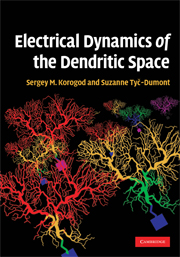Book contents
- Frontmatter
- Contents
- Preface
- 1 Definition of the neuron
- 2 3D geometry of dendritic arborizations
- 3 Basics in bioelectricity
- 4 Cable theory and dendrites
- 5 Voltage transfer over dendrites
- 6 Current transfer over dendrites
- 7 Electrical structure of an artificial dendritic path
- 8 Electrical structure of a bifurcation
- 9 Geography of the dendritic space
- 10 Electrical structures of biological dendrites
- 11 Electrical structure of the whole arborization
- 12 Electrical structures in 3D dendritic space
- 13 Dendritic space as a coder of the temporal output patterns
- 14 Concluding remarks
- Index
- References
12 - Electrical structures in 3D dendritic space
Published online by Cambridge University Press: 03 May 2010
- Frontmatter
- Contents
- Preface
- 1 Definition of the neuron
- 2 3D geometry of dendritic arborizations
- 3 Basics in bioelectricity
- 4 Cable theory and dendrites
- 5 Voltage transfer over dendrites
- 6 Current transfer over dendrites
- 7 Electrical structure of an artificial dendritic path
- 8 Electrical structure of a bifurcation
- 9 Geography of the dendritic space
- 10 Electrical structures of biological dendrites
- 11 Electrical structure of the whole arborization
- 12 Electrical structures in 3D dendritic space
- 13 Dendritic space as a coder of the temporal output patterns
- 14 Concluding remarks
- Index
- References
Summary
For the biologist, the gap between results of model computation and live neurons is filled when an electrical structure is mapped on the static anatomy of the dendritic field of neurons. The speaking likeness of these 3D images opens a new way of thinking by providing a functional image of 3D dendritic space. Indeed it is new because the question of the electrical state of the whole dendritic space is rarely addressed, although critical for understanding how the neuron processes its inputs.
The three types of neurons investigated here have their own idiosyncratic 3D dendritic pattern so well described in morphological words. In Chapters 10 and 11, we explore the arborizations as determinants of their spatial electrical properties without referring to the dendritic geometry as an object inserted in physical 3D space. The restriction of this view can be explained with a simple analogy. This is a view of the dendrites ‘from the inside’.
We can imagine the dendritic arborization as a ‘cave maze’ in the brain's depths. When we are inside the maze, we do not perceive its 3D shape. We can wander inside, uncoiling ‘Ariadne's thread’ on our path from the entry (the soma) to the deadlocks (the distal tips) and then measure the length of the threads between those points to find the path lengths. Another spatial information available from the interior view is the diameter of the ‘cave’ at each site along the path. Knowing the lengths and diameters of all the paths in such a labyrinth is sufficient for computing the spatial electrical structures.
- Type
- Chapter
- Information
- Electrical Dynamics of the Dendritic Space , pp. 161 - 172Publisher: Cambridge University PressPrint publication year: 2009



